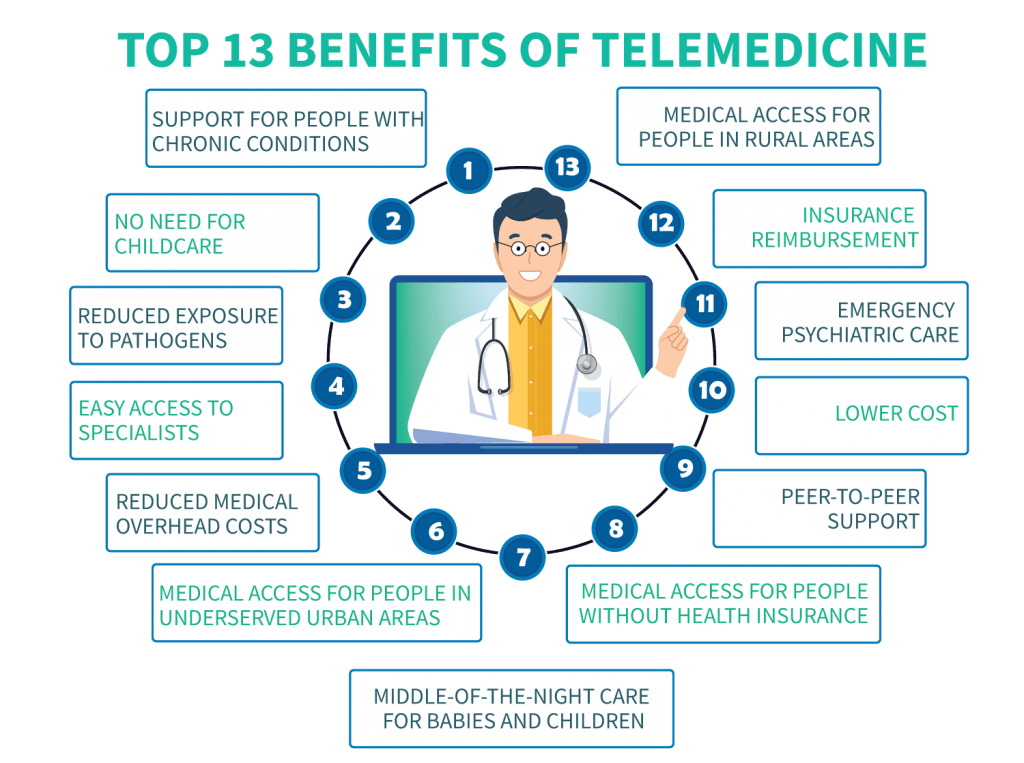Top 13 Advantages of Telemedicine Technology in Healthcare
Telemedicine technology has seen rapid growth in the last few years. It is now an integral part of healthcare delivery in many parts of the world. Its primary objective is to ensure that patients in remote areas have access to medical care.
Telemedicine allows patients in remote or underserved areas to consult specialists, have tests, and get treatments without traveling.
The technology has numerous benefits, including cost-efficiency, insurance reimbursement, reduced travel time, and medical access for people without health insurance.
But Telemedicine isn’t all fun and games. In this blog, we’ll cover the telemedicine advantages in healthcare and how it can help you stay in touch with the doctor even when you are far away from home.
Table of Contents
- Top 13 Benefits of Telemedicine Technology
- 1. Easy access to specialists
- 2. Lower cost
- 3. Medical access for people without health insurance
- 4. No Need for Childcare
- 5. Middle-of-the-night care for babies and children
- 6. Reduced exposure to pathogens
- 7. Medical access for people in underserved urban areas
- 8. Medical access for people in rural areas
- 9. Insurance reimbursement
- 10. Emergency psychiatric care
- 11. Peer-to-peer support
- 12. Support for people with chronic conditions
- 13. Reduced medical overhead costs
- Conclusion
Top 13 Benefits of Telemedicine Technology
Telemedicine technology, also known as telehealth, allows healthcare providers to offer remote medical services through technology such as the benefits of video conferencing, mobile apps, and other digital platforms. Here are the top 13 benefits of Telemedicine technology:

1. Easy access to specialists
Telemedicine is a powerful technology that allows patients to access health care services without necessarily visiting a doctor’s office in person. With Telemedicine, patients can easily access specialists regardless of their location.
It helps get rid of the barriers to Telemedicine.
This eliminates the need for long-distance travel and makes faster and more efficient treatment possible. Furthermore, Telemedicine allows patients and health professionals to interact more flexibly, improving patient satisfaction.
Telemedicine also allows for safer treatment due to the additional safety measures. In addition, Telemedicine allows healthcare providers to communicate remotely and work in a virtual environment, providing safer and more effective patient care.
2. Lower cost
Telemedicine technology has many benefits in healthcare. For example, Telemedicine platforms allow for remote diagnosis and treatment of conditions, which can reduce the number of visits to the doctor or hospital.
In addition, Telemedicine allows for more coordinated care between doctors and nurses, which can improve patient outcomes. Telemedicine also costs less than traditional methods of healthcare delivery, making it a cost-effective solution for treatment-intensive conditions.
Overall, telemedicine technology is a powerful tool in providing healthcare services that can help improve patient outcomes and reduce costs.
3. Medical access for people without health insurance
Many people in the United States do not have health insurance, and many others cannot afford to pay for expensive medical treatments. Telemedicine advantage can provide healthcare services to uninsured or underinsured patients without visiting a doctor’s office.
4. No Need for Childcare
Telemedicine technology has the potential to revolutionize healthcare and make it more efficient. It allows patients to see their doctors and specialists without having to travel. It also allows parents to work from home, reducing the need for childcare.
Of course, telemedicine technology benefits patients in other ways, too. For instance, a White-label telemedicine platform can improve the quality of care provided by doctors and nurses, leading to better patient outcomes.
5. Middle-of-the-night care for babies and children
Telemedicine technology can provide middle-of-the-night care for babies and children.
This allows parents to get much-needed sleep while their children are cared for by a qualified healthcare professional. Telemedicine can also diagnose and treat pediatric illnesses, saving lives and reducing children’s hospitalizations.
Additionally, Telemedicine provides remote patient education and support, allowing healthcare providers to provide specialized care without physically being in the patient’s home or workplace.
By combining Telemedicine with advanced medical technology, healthcare providers can provide care tailored specifically to individual patients’ needs.
6. Reduced exposure to pathogens
Telemedicine is a technology that allows healthcare providers to diagnose and treat patients remotely. By reducing the exposure of healthcare providers to pathogens, Telemedicine helps protect them from infection.
Telemedicine also allows patients to see healthcare providers remotely, which can reduce the time they spend traveling to appointments. As a result, Telemedicine allows healthcare providers and patients to continue their care more timely while avoiding unnecessary risks and complications.
7. Medical access for people in underserved urban areas
Telemedicine is a healthcare delivery method that uses technology to connect people with healthcare providers in remote locations. It has several patient benefits, including improved care access, decreased costs, and increased efficiency.
Telemedicine allows patients to receive medical treatment from doctors and specialists in other parts of the country or world. This can lead to faster diagnosis and treatment and improved patient satisfaction.
Telemedicine also reduces medical services’ costs by allowing patients to see doctors who are more specialized in their field. As a result, Telemedicine is vital for improving patient access to high-quality health care in underserved urban areas.
Are you looking for a Telemedicine Solutions?
8. Medical access for people in rural areas
Telemedicine allows healthcare providers to provide medical care to patients who cannot travel to a clinic or hospital. By using Telemedicine, rural communities can benefit from the benefits of care in urban areas, such as access to doctors and advanced technology.
Telemedicine can also diagnose and treat chronic diseases, improving the quality of care for people with these conditions.
By using telemedicine technology, remote populations can access medical care from a doctor or nurse no matter where they are in the world. In addition, Telemedicine technology allows patients with chronic conditions to stay in control of their health and reduce the risk of complications while receiving treatment.
Overall, Telemedicine is a cost-effective and beneficial way of providing healthcare services that can help improve the health of rural communities worldwide.
9. Insurance reimbursement
Telemedicine is a growing trend in healthcare that allows patients to receive treatment from doctors remotely. Telemedicine allows patients to get medical care without traveling to a hospital or medical office. This technology has many benefits, such as reducing costs and improving patient satisfaction.
Insurance companies are starting to reimburse telemedicine services, making them more affordable for patients. Telemedicine services can also reduce healthcare costs by allowing patients to receive treatments in their homes instead of in a clinical setting.
10. Emergency psychiatric care
Telemedicine technology can improve the quality of psychiatric care by providing access to specialists who are unavailable in person. In addition, it allows for timely and accurate information about a patient’s health status that can help with treatment decisions.
Telemedicine also helps reduce patients’ time in hospitals or psychiatric care facilities by allowing them to be closer to their communities. Finally, Telemedicine enables care coordination between different healthcare providers allowing for better-coordinated care and treatment.
Overall, telemedicine technology can improve the quality of psychiatric care by providing access to specialists who are unavailable in person.
11. Peer-to-peer support
Telemedicine technology can improve patient safety, timely treatment, and cost savings.
One of the ways Telemedicine helps improve patient safety is by allowing healthcare professionals to remotely care for patients who cannot travel to a hospital. In addition, Telemedicine can provide care to patients who cannot travel to a hospital due to a medical condition or another physical barrier.
12. Support for people with chronic conditions
Telemedicine technology can support people with chronic disease conditions by providing them access to healthcare from anywhere in the world. It allows patients to receive treatment remotely, leading to improved quality of care and faster recovery times. In addition, telemedicine technology can help manage chronic conditions more effectively by providing real-time information about a patient’s condition.
13. Reduced medical overhead costs
Telemedicine technology has several benefits in healthcare. Telemedicine allows for remote patient care, which can reduce medical overhead costs and improve patient satisfaction.
Through telemedicine technology, healthcare providers can provide care from anywhere in the world with internet access. This reduces the need for hospitalizations and the risk of adverse events in patient care.
Moreover, Telemedicine reduces training requirements for healthcare professionals, leading to increased efficiency in the healthcare system. All in all, telemedicine technology is revolutionizing healthcare delivery around the world.
Conclusion
Telemedicine is more cost-effective and efficient than travel-based care in rural and remote areas of the country.
The technology of Telemedicine has changed the face of healthcare in India, bringing quality medical care to millions of people in remote areas without access to it.
Telemedicine has allowed healthcare providers in metropolitan centers to provide high-quality healthcare services with minimal travel time and cost. It has also helped in reducing medical errors and improving patient satisfaction.
With Telemedicine, healthcare professionals in metropolitan centers can provide well-coordinated care that matches the needs of patients in rural areas. There is an urgent need for telemedicine in India.
We hope this blog shared some of the top benefits of Telemedicine for patients and inspired you to use telehealth technology in your healthcare system!




